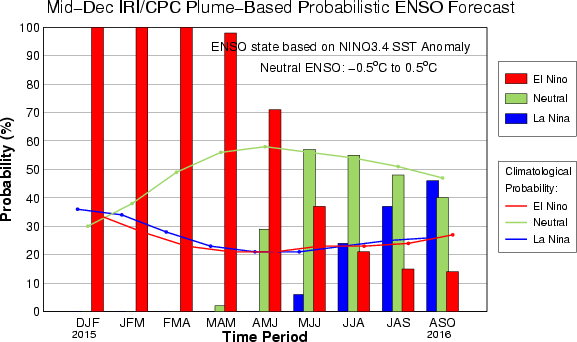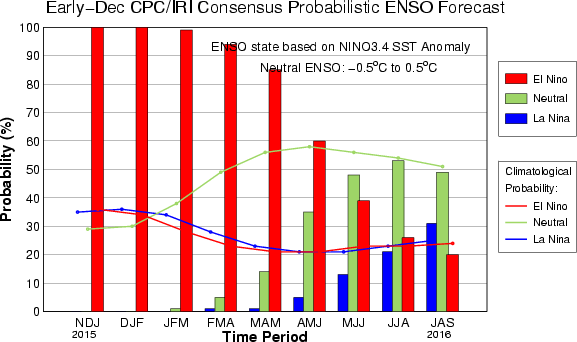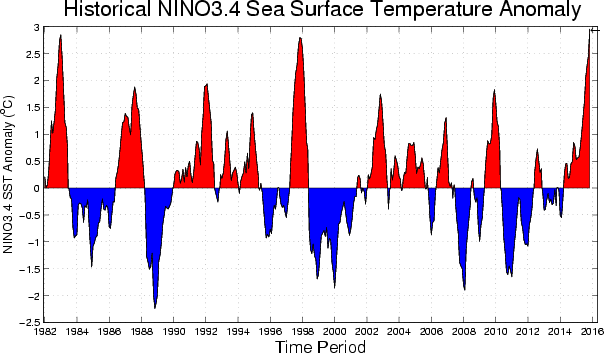IRI ENSO Forecast
IRI Technical ENSO Update
Published: December 17, 2015
Note: The SST anomalies cited below refer to the OISSTv2 SST data set, and not ERSSTv4. OISSTv2 is often used for real-time analysis and model initialization, while ERSSTv4 is used for retrospective official ENSO diagnosis because it is more homogeneous over time, allowing for more accurate comparisons among ENSO events that are years apart. During ENSO events, OISSTv2 usually shows stronger anomalies than ERSSTv4, and during very strong events the two datasets may differ by as much as 0.5 C. Therefore, the anomalies cited below for this strong 2015-16 event are likely larger than those that will later be cited officially, particularly in comparisons with other strong El Niño events like 1997-98 and 1982-83.
Recent and Current Conditions
The SST anomaly in the NINO3.4 region attained a weak El Niño level beginning late February 2015, strengthened to moderate strength around mid-May, and strengthened further to a strong level beginning around mid-July. For November the average NINO3.4 SST anomaly was 2.96 C, indicative of strong El Niño conditions, and for Sep-Nov it was 2.57 C. The IRI’s definition of El Niño, like NOAA/Climate Prediction Center’s, requires that the SST anomaly in the Nino3.4 region (5S-5N; 170W-120W) exceed 0.5 C. Similarly, for La Niña, the anomaly must be -0.5 C or less. The climatological probabilities for La Niña, neutral, and El Niño conditions vary seasonally, and are shown in a table at the bottom of this page for each 3-month season. The most recent weekly SST anomaly in the Nino3.4 region was 2.8 C, in the category of strong El Niño. Accompanying this SST has been a clear and strong El Niño atmospheric pattern, including westerly low-level wind anomalies and positive anomalies of convection near and east of the dateline. The Southern Oscillation Index (SOI) and the equatorial SOI have also been quite negative, indicative of El Niño conditions.
Expected Conditions
What is the outlook for the ENSO status going forward? The most recent official diagnosis and outlook was issued one week ago in the NOAA/Climate Prediction Center ENSO Diagnostic Discussion, produced jointly by CPC and IRI; it called for this El Niño to remain strong through this 2015-16 winter, then weaken and dissipate to neutral by late spring or early summer 2016. The latest set of model ENSO predictions, from mid-Nov, now available in the IRI/CPC ENSO prediction plume, is discussed below. Currently, besides weekly Nino3.4 SST anomalies being in the strong El Niño category, subsurface temperature anomalies across the eastern equatorial Pacific have been at well above average levels, although they are now beginning to weaken somewhat. The strong positive heat content anomaly promoted steady increases in SST over the last 5 months. So far during December a slight weakening is being observed. It is possible that November marked the peak of the event in terms of 1-month average SST, and OND may become the period of peak 3-month SST for the event. In the atmosphere, the basin-wide sea level pressure anomaly pattern (e.g. the SOI) has been clearly at El Niño levels. Anomalous convection (as measured by OLR) has been above average both near and just east of the dateline. Together, the oceanic and atmospheric features reflect strong El Niño conditions for late November through mid-December.
As of mid-December, none of the dynamical or statistical models models predicts La Niña or neutral SST conditions for the initial Dec-Feb 2015-16 season; 100% predicts El Niño conditions. At lead times of 3 or more months into the future, statistical and dynamical models that incorporate information about the ocean’s observed subsurface thermal structure generally exhibit higher predictive skill than those that do not. For the Mar-May 2016 season, among models that do use subsurface temperature information, 95% predicts El Niño SST conditions, while 5% predicts ENSO-neutral conditions and none predicts La Niña conditions. For all model types, the probabilities for El Niño are near 100% (i.e., higher than 99.5%) for Dec-Feb 2015-16 through Feb-Apr 2016, dropping toward 90% for Mar-May and down just below 50% by May-Jul and lower thereafter. No model predicts La Niña conditions for any forecast period through Mar-May 2016, but the chances rise to near 25% by Jun-Aug and nearly 40% for Aug-Oct. Chances for neutral ENSO conditions are near 0% through Feb-Apr 2016, then rising to near 50% by May-Jul.
Note – Only models that produce a new ENSO prediction every month are included in the above statement.
Caution is advised in interpreting the distribution of model predictions as the actual probabilities. At longer leads, the skill of the models degrades, and skill uncertainty must be convolved with the uncertainties from initial conditions and differing model physics, leading to more climatological probabilities in the long-lead ENSO Outlook than might be suggested by the suite of models. Furthermore, the expected skill of one model versus another has not been established using uniform validation procedures, which may cause a difference in the true probability distribution from that taken verbatim from the raw model predictions.
An alternative way to assess the probabilities of the three possible ENSO conditions is more quantitatively precise and less vulnerable to sampling errors than the categorical tallying method used above. This alternative method uses the mean of the predictions of all models on the plume, equally weighted, and constructs a standard error function centered on that mean. The standard error is Gaussian in shape, and has its width determined by an estimate of overall expected model skill for the season of the year and the lead time. Higher skill results in a relatively narrower error distribution, while low skill results in an error distribution with width approaching that of the historical observed distribution. This method shows probabilities for La Niña at near-zero from Dec-Feb 2015-16 through Apr-Jun 2016, and up to approximately 45% by Aug-Oct 2016. Model probabilities for neutral ENSO conditions are less than 5% through Mar-May 2016, close to 30% for Apr-Jun and approximately 50% from May-Jul through Jul-Sep, and dropping to near 40% for Aug-Oct. Probabilities for El Niño are near 100% from Dec-Feb 2015-16 to Feb-Apr 2016, in the upper 90s for Mar-May, near 70% for Apr-Jun, and below 50% beginning in May-Jul, dropping to below 20% beginning in Jul-Sep. A plot of the probabilities generated from this most recent IRI/CPC ENSO prediction plume using the multi-model mean and the Gaussian standard error method summarizes the model consensus out to about 10 months into the future. The same cautions mentioned above for the distributional count of model predictions apply to this Gaussian standard error method of inferring probabilities, due to differing model biases and skills. In particular, this approach considers only the mean of the predictions, and not the total range across the models, nor the ensemble range within individual models.
The probabilities derived from the models on the IRI/CPC plume describe, on average, extremely high certainty for El Niño conditions for the Dec-Feb 2015-16 through Mar-May 2016 seasons. In terms of magnitude, the models suggest that we have already hit the peak SST anomaly values, around roughly 2.5C for the NDJ season, but still predict between 2.0 and 2.7 for DJF. Model forecast spread still exists, implying there is a slight possibility of being outside of that interval on either side. A caution regarding this latest set of model-based ENSO plume predictions, is that factors such as known specific model biases and recent changes that the models may have missed will be taken into account in the next official outlook to be generated and issued in early October by CPC and IRI, which will include some human judgement in combination with the model guidance.
Climatological Probabilities
| Season |
La Niña |
Neutral |
El Niño |
| DJF |
36% |
30% |
34% |
| JFM |
34% |
38% |
28% |
| FMA |
28% |
49% |
23% |
| MAM |
23% |
56% |
21% |
| AMJ |
21% |
58% |
21% |
| MJJ |
21% |
56% |
23% |
| JJA |
23% |
54% |
23% |
| JAS |
25% |
51% |
24% |
| ASO |
26% |
47% |
27% |
| SON |
29% |
39% |
32% |
| OND |
32% |
33% |
35% |
| NDJ |
35% |
29% |
36% |

IRI/CPC Mid-Month Plume-Based ENSO Forecast Probabilities
| Season |
La Niña |
Neutral |
El Niño |
| DJF 2016 |
~0% |
~0% |
100% |
| JFM 2016 |
~0% |
~0% |
100% |
| FMA 2016 |
~0% |
~0% |
100% |
| MAM 2016 |
~0% |
2% |
98% |
| AMJ 2016 |
~0% |
29% |
71% |
| MJJ 2016 |
6% |
57% |
37% |
| JJA 2016 |
24% |
55% |
21% |
| JAS 2016 |
37% |
48% |
15% |
| ASO 2016 |
46% |
40% |
14% |



